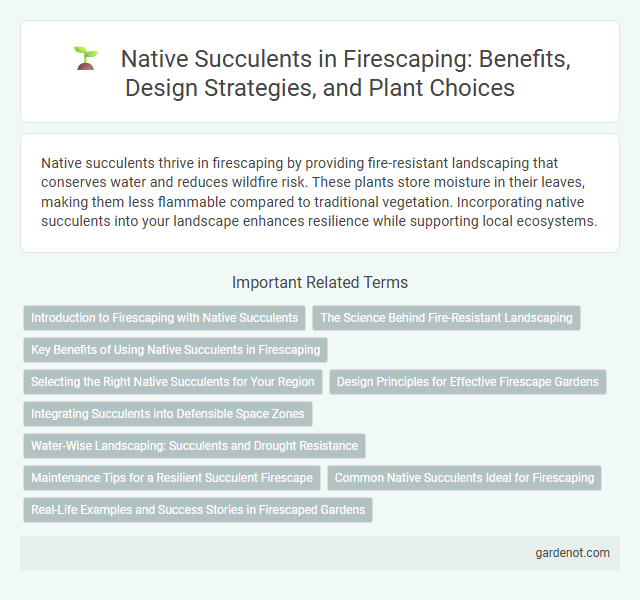Native succulents thrive in firescaping by providing fire-resistant landscaping that conserves water and reduces wildfire risk. These plants store moisture in their leaves, making them less flammable compared to traditional vegetation. Incorporating native succulents into your landscape enhances resilience while supporting local ecosystems.
Introduction to Firescaping with Native Succulents
Native succulents play a crucial role in firescaping by providing fire-resistant landscaping options that minimize wildfire risks. Their thick, water-retentive leaves reduce the likelihood of ignition, making them ideal for creating defensible spaces around homes in fire-prone areas. Incorporating native succulent species such as Dudleya and Agave enhances both wildfire resilience and local biodiversity.
The Science Behind Fire-Resistant Landscaping
Native succulents possess unique cellular structures that store water, enhancing their natural fire-resistant properties by reducing flammability and heat conduction. Their thick, fleshy leaves contain high moisture content, which acts as a natural barrier to fire spread in firescaping designs. Incorporating native succulents in fire-resistant landscaping strategically lowers the risk of wildfires by creating defensible spaces with plants that resist ignition and slow fire progression.
Key Benefits of Using Native Succulents in Firescaping
Native succulents offer exceptional drought tolerance and fire resistance, making them ideal for firescaping in arid and fire-prone regions. Their low water requirements reduce irrigation needs, while their thick, water-storing leaves help minimize fire spread by retaining moisture even during dry conditions. Incorporating native succulents enhances landscape resilience, promotes biodiversity, and supports local ecosystems in fire-adapted environments.
Selecting the Right Native Succulents for Your Region
Selecting the right native succulents for your region ensures optimal growth and drought resilience in firescaping landscapes. Research species like Agave utahensis in arid western areas or Dudleya brittonii along California coastlines for fire-resistant qualities and compatibility with local climates. Regional adaptation minimizes water use and supports ecosystem balance while enhancing fire safety.
Design Principles for Effective Firescape Gardens
Native succulents thrive in firescape gardens due to their drought tolerance and low fuel potential, making them ideal for fire-resistant landscaping. Design principles emphasize strategic plant placement with adequate spacing and use of fire-resistant mulch to minimize fire spread while maintaining aesthetic appeal. Integrating native succulents with complementary fire-adapted species enhances resilience and supports local biodiversity in fire-prone areas.
Integrating Succulents into Defensible Space Zones
Integrating native succulents into defensible space zones enhances fire resistance due to their high moisture content and low flammability. Species like Agave, Sedum, and Euphorbia create natural firebreaks while supporting local biodiversity and reducing maintenance needs. Proper spacing and placement within zones 0 to 3 help prevent fire spread and promote a resilient landscape design.
Water-Wise Landscaping: Succulents and Drought Resistance
Native succulents are ideal for water-wise landscaping due to their exceptional drought resistance and minimal irrigation requirements. These plants, adapted to arid environments, store water in their thick, fleshy leaves, enabling survival during prolonged dry periods and reducing wildfire risk by maintaining moisture levels. Incorporating native succulents into firescaping not only conserves water but also enhances landscape resilience against extreme heat and drought conditions.
Maintenance Tips for a Resilient Succulent Firescape
Native succulents thrive in firescaping due to their drought tolerance and low maintenance needs, requiring minimal watering once established. Prune dead or damaged leaves regularly to promote airflow and prevent pest infestations, enhancing their resilience in fire-prone areas. Mulching with gravel or sand helps retain moisture and reduces weed growth, supporting a healthy and fire-resistant succulent landscape.
Common Native Succulents Ideal for Firescaping
Common native succulents ideal for firescaping include species such as Agave parryi, Dudleya pulverulenta, and Echeveria elegans, which exhibit natural fire-resistant properties due to their high moisture content and low volatility. These drought-tolerant plants thrive in arid climates, requiring minimal irrigation and reducing overall fuel load around structures. Integrating native succulents into defensible space designs enhances landscape resilience while maintaining ecological balance and aesthetic appeal.
Real-Life Examples and Success Stories in Firescaped Gardens
Native succulents such as Agave, Yucca, and Opuntia have proven highly effective in firescaped gardens by reducing flammable vegetation and enhancing drought resistance. In California's wildfire-prone regions, homeowners successfully integrated native succulents, leading to slower fire spread and improved garden resilience, as documented in studies by the University of California Cooperative Extension. These real-life examples highlight how incorporating native succulents supports fire-adaptive landscaping while maintaining ecological balance and visual appeal.
Native succulent Infographic

 gardenot.com
gardenot.com